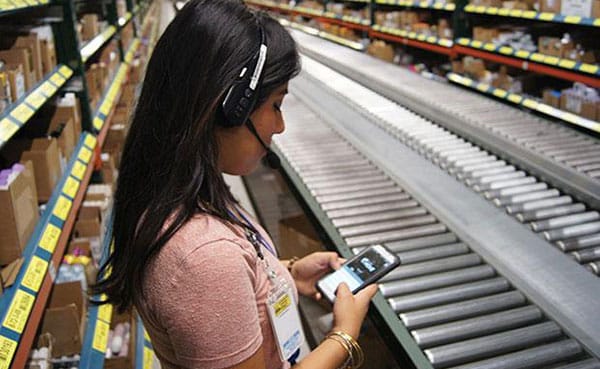Lessons Retailers Can Learn From Their Distribution Centers
The Covid-19 pandemic has accelerated ecommerce in many retail segments, driving tremendous growth of store-based fulfillment of online orders, especially for groceries, health and wellness products, and other household essentials. The surge in ecommerce has also exposed the inefficiencies of manual in-store picking processes, resulting in delays and long lead times as many stores struggle to scale up to meet demand.
The key to successfully navigating the rise in demand for local pick up and delivery is to improve efficiency and scalability of store-based fulfillment. Stores will need to employ the same process and operations best practices that have been used for years in DCs. Those best practices can help retailers improve margins and profits on local fulfillment of ecommerce orders.
In addition to borrowing process smarts from their DCs, stores will also need to adopt optimization tools and technology similar to that used to optimize, orchestrate and direct the work of their DC-based fulfillment teams. Fortunately, many stores have already installed the technologies needed to support this, including cloud-based POS and inventory systems, in-store WiFi, and user-friendly Android mobile computers and scanners.
The Challenge of Store-Based Fulfillment
In theory, customer pick up and local delivery should reduce ecommerce fulfillment costs. In practice, however, most retailers are losing money on local fulfillment due to inefficient, labor intensive in-store picking processes. This bad situation may get even worse as ecom orders increase. To avoid that, stores will need to start operating more like DCs when it comes to filling orders from store inventory.
It’s worth recognizing that optimizing in-store picking poses unique challenges, both from an accuracy and efficiency perspective. For instance, store layouts and product positioning are based on maximizing sales rather than minimizing travel per shopping (or picking) trip. Likewise, it’s nearly impossible to get accurate real-time inventory when shoppers can empty shelves before the inventory system is updated. Finally, most stores are constrained for space which limits their ability to carve out separate areas dedicated to in-store picking, order assembly and pick up.
Over the long haul, robotics and automation will play a key role in boosting the efficiency and cost-effectiveness of local fulfillment. But many retailers will not be around in the long term if they cannot earn profits in the short term on orders fulfilled from stores.
Fulfillment Best Practices For Stores
Despite the challenges, there are many things that retailers can do to improve the efficiency and throughput of their store-based fulfillment processes. The following DC best practices would apply to dark stores (locations dedicated to delivery and pick up only) and hybrid stores serving ecom and in-person shoppers.
To successfully implement these strategies, stores will also require optimization software that can:
- Prioritize orders in real time, as orders are received throughout the day
- Orchestrate complex picking and order assembly processes across many associates
- Direct individual associates using a variety of mobile tools and technologies
- Report real-time work status, results and exception conditions (stock outs, product damage) to managers
Directed Picking
Many stores are already using mobile devices similar to those used in DCs to direct associates through their tasks, but most stores have not optimized the workflows to take full advantage of all of the mobile tools at their disposal. By contrast, most DCs have spent years squeezing inefficiency out of their picking processes by combining a variety of output and data capture technologies including voice, scanning and displays.
Multi-modal, voice-directed picking systems improve productivity and accuracy, slash training time, and help new employees get up to speed faster:
- Voice direction frees pickers from looking at screens so their eyes can focus on what they need to pick and where they need to go.
- Associates confirm the items they are picking and where they are putting them using a combination of speech recognition and barcode scanning.
- Visual information delivered on a mobile device or smartwatch, and voice-enabled help functions, reduce errors and minimize supervisor intervention and help.
Zone-Based Picking
Rather than picking orders complete across an entire store, it may be useful to separate your stores by zone, and to split orders across the areas. Zone-based picking increases throughput, and makes it easier to handle rush orders. Other advantages include:
- Optimize picking processes according to zone. For example, stores can use different sized carts and/or picking containers in different areas (health and beauty; paper and cleaning products; shoes; apparel; etc.) to maximize the number of picks per trip based on the size of product packages and/or the numbers of items per order.
- Allow managers to assign more experienced associates in areas where additional expertise is needed – produce or apparel, for example – rather than requiring every associate (including trainees) to be expert in all product areas.
Zone-based picking requires stores to create processes for staging and merging items picked in different zones (more about this below). It also requires software tools to manage the priority and sequencing of work.
Travel Optimization
In the typical DC, workers are directed through their picking tasks based on the location sequence of products so that they can move in one direction up and down aisles without back-tracking or wasting steps. Lucas AI-based software goes one step further and applies travel optimization algorithms to calculate the shortest travel routes through a DC or store.
Lucas overrides simple pick sequences and allows associates to begin an assignment at any place in the store. This helps address the unique challenges of store layouts. In addition, the algorithms can recalculate based on store traffic – for example, if an associate chooses to skip a congested aisle.
Order Batching
Instead of picking one order at a time for every trip through a store (or zone) store associates can save steps and increase productivity by picking multiple orders per trip (using a cart with totes or subdivided by order). For stores that can split orders by zones, the batch sizes can be different in each zone, depending on a number of factors, including average items per order, size/weight of items, etc.
Lucas introduced AI-based batching optimization tools that can both maximize cart fill rates (the percentage of cart capacity that is used) and minimize travel time per cart.
Two-Stage Picking
Many DCs use two-stage picking processes to dramatically improve the picking efficiency for so-called slow-moving items. The slow movers are picked in very large batches and staged for a secondary pick in the main order picking process (described in this video animation).
With a two-stage process, all of the slow movers in a large number of orders can be picked in advance of the rest of the items in those orders. The pre-picked slow movers are staged at a designated location where associates picking the rest of the order can grab them within their picking sequence. In effect, the staging location becomes a second pick location. Some DCs have doubled or tripled the productivity of picking slow movers using a two-stage picking process.
Order Assembly and QC
There are a number of proven methods for sorting, merging and assembling orders in the DC that apply to store-based fulfillment. In two-stage picking, pre-picked items are added to an order as it is picked. For other zones, put-to-order processes are used to break down completed batches of orders and merge items from multiple zones into final order groupings. (One popular method for doing this is follow-the-leader, which is described in this short animation.) System-directed put, sort, and merge processes ensure accuracy and efficiency, similar to directed picking. This is also an opportunity to add a final QC step, either as a “blind” audit (scan every item); count verification (check the number of items); or visual inspection (‘check’ items off the list).
Store-Based Fulfillment: The Future Is Now
Covid-19 has accelerated the ecommerce transition in retail and put new and unexpected stress on local fulfillment strategies. In-store picking processes that were good-enough with low order volumes do not scale efficiently to meet rising demand. Retailers need to rapidly move beyond limited pilots of store-based fulfillment to higher throughput “production” capabilities. The fastest way to do that is to adapt the process innovations and technologies from their DCs to the unique challenges of stores.
To learn more about ways to improve in-store picking, check out our brief animation below.





